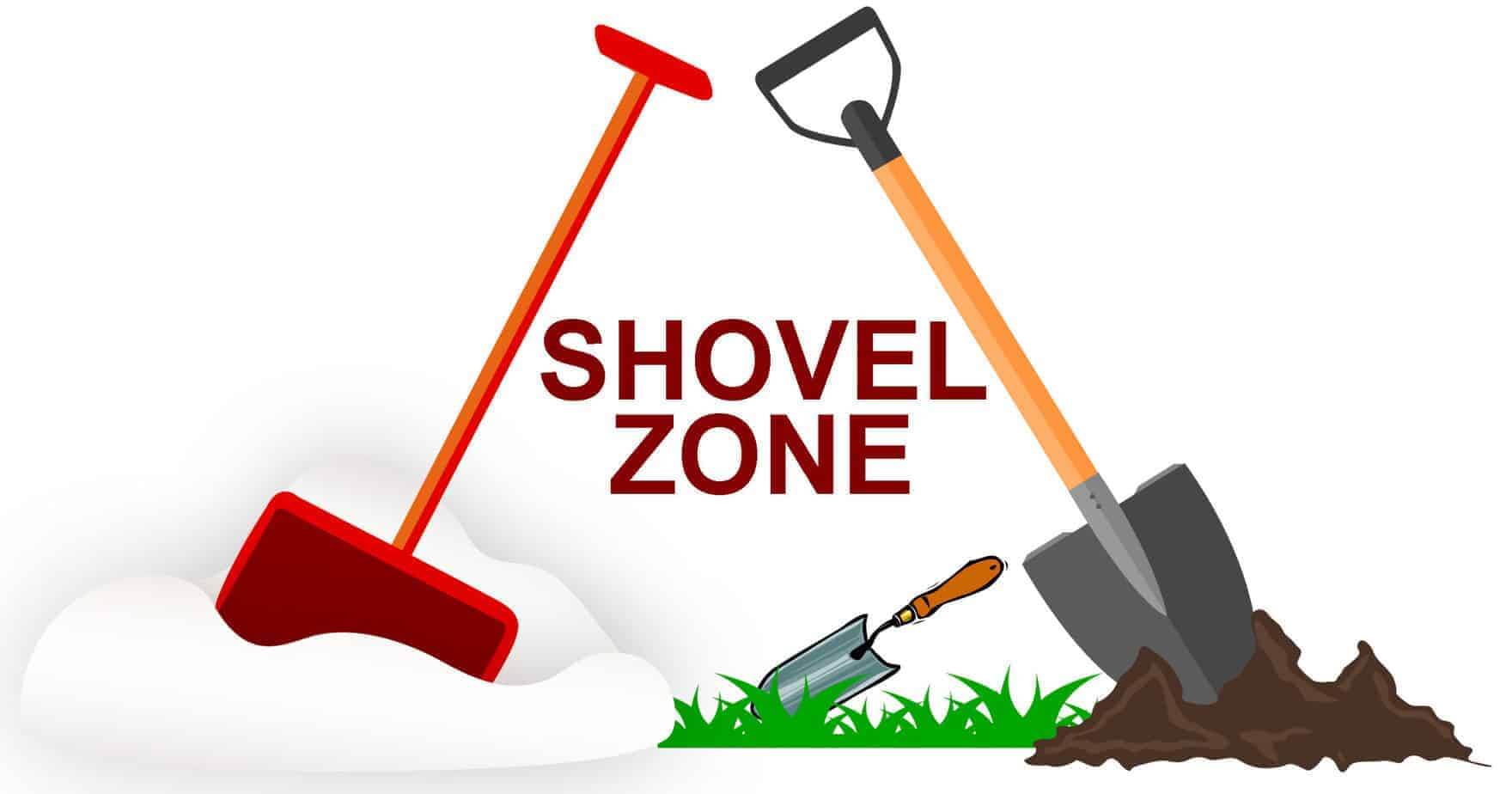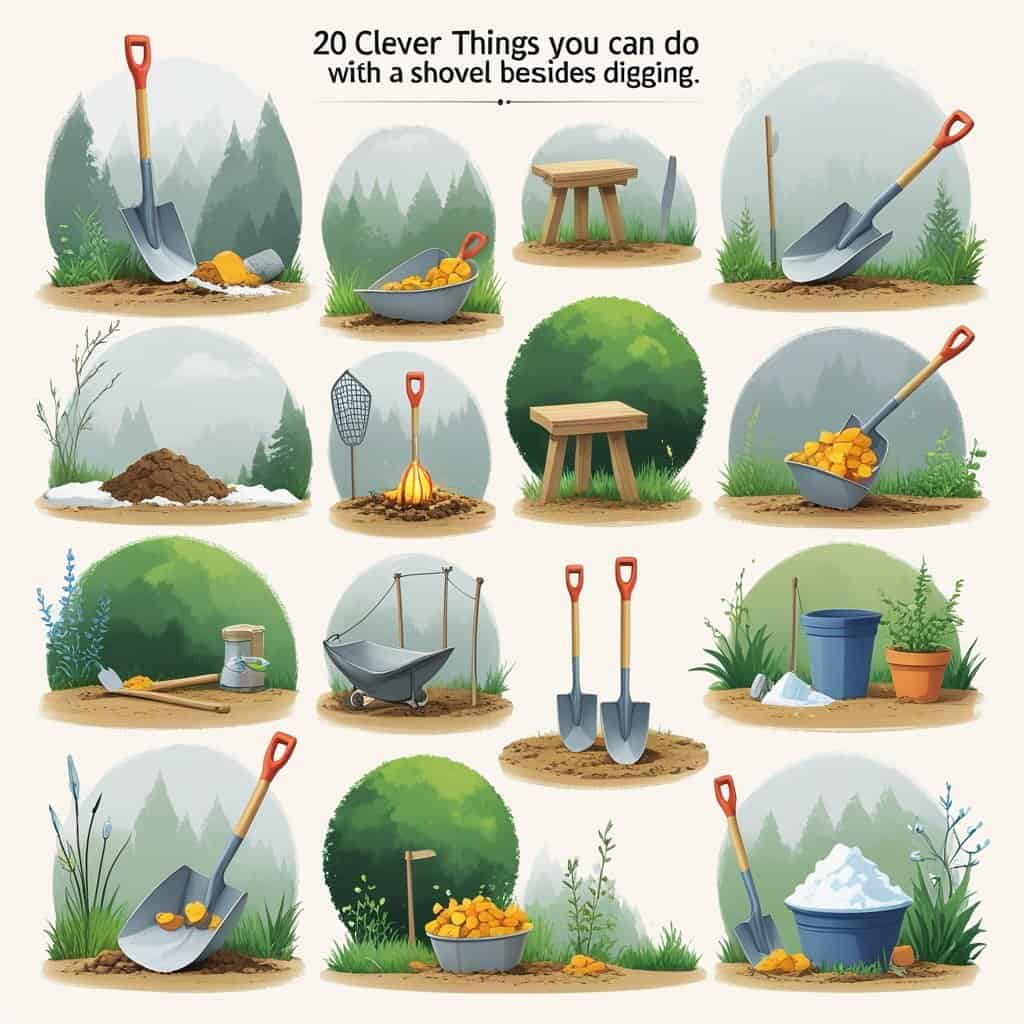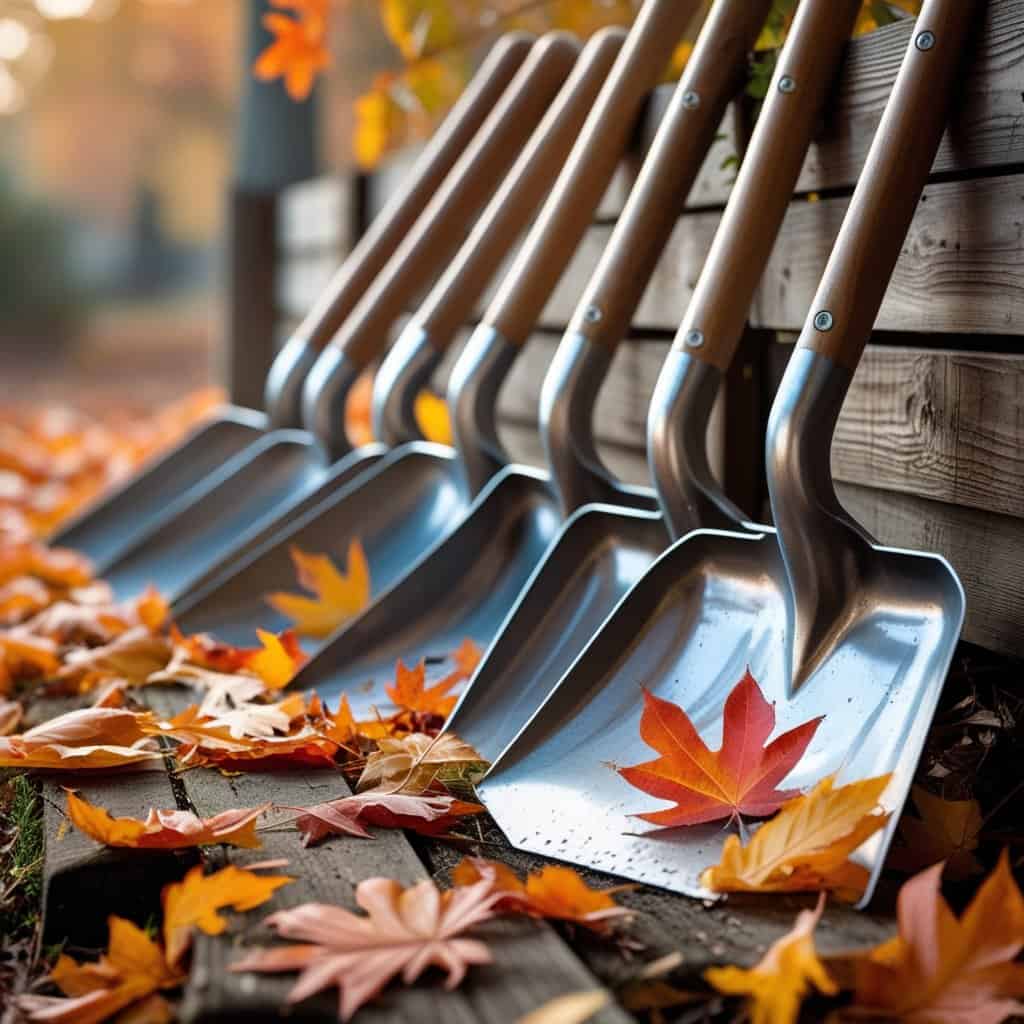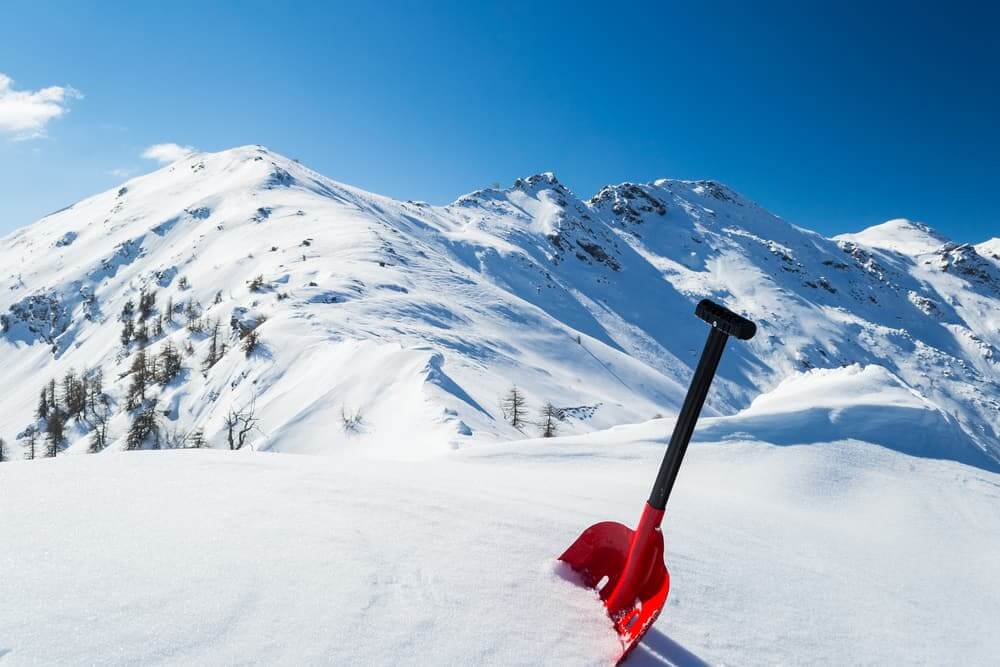A shovel may seem like a simple tool, but it can do far more than move dirt. With a little imagination, this everyday item becomes a versatile piece of equipment with uses that go well beyond digging.
Here are 20 clever things you can do with a shovel that go beyond just digging.
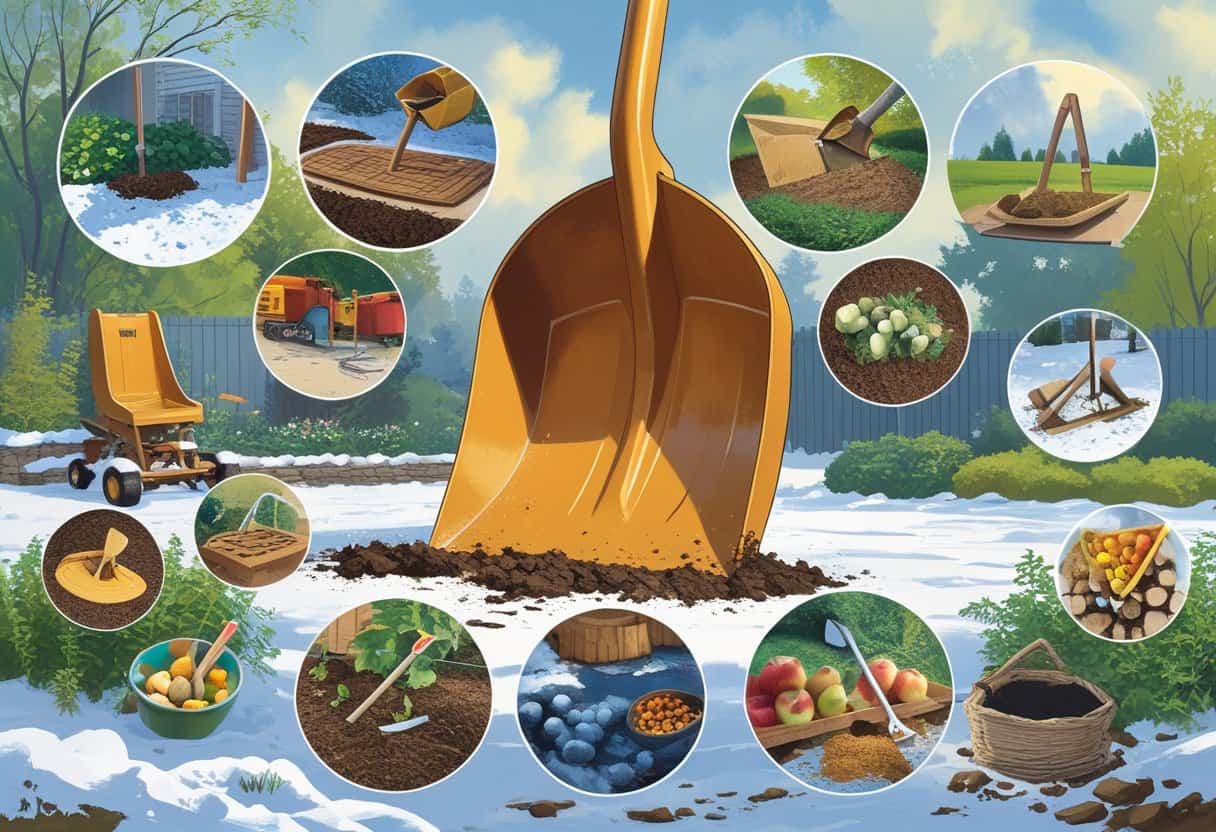
In this article, we’ll explore clever ways to repurpose and adapt shovels for practical needs and creative projects. From turning old shovel heads into planter stands or bird feeders to using them as trellises or rustic garden signs, we’ll show how to give new life to tools that might otherwise sit forgotten in a shed.
Table of Contents
20 Clever Things You Can Do with a Shovel -Creative Repurposing Ideas
We can turn old shovels into functional and decorative pieces that add character to our spaces. With a little effort, they become planters, signs, art, or even rustic home accents that serve a new purpose.
Garden Art Projects
Old shovel heads make excellent bases for outdoor art. Their curved metal surface works well as a canvas for painting simple designs like flowers, birds, or seasonal themes.
Even a light coat of paint with stencils can transform a rusty tool into a colorful garden accent. For a more advanced project, we can weld or arrange multiple shovels into larger sculptures.
Some people create abstract shapes, while others build figures like sunflowers or animals. Using a few different sizes or colors adds depth and makes the piece stand out.
Another idea is to cut designs into the metal using a plasma cutter. We can create patterns such as leaves, vines, or geometric shapes.
When sunlight shines through, it casts interesting shadows across the garden. This approach works best if we want a mix of art and function.
DIY Shovel Planters
A shovel head naturally holds soil, making it easy to repurpose into a planter. We can secure it to a wall, fence, or post and fill it with trailing flowers or succulents.
Adding chicken wire and moss creates a small basket effect that helps keep the soil in place. Leaning a shovel against a wall with a pot ring attached to the handle is another practical option.
This setup allows us to display cascading plants without taking up much ground space. For a larger display, several shovel heads can be mounted on a wooden pole to form tiered planter shelves.
This design saves space while creating a vertical garden feature. It is an efficient way to showcase multiple plants in one compact area.
Unique Home Decor
Shovels can also be adapted for indoor or porch use. A short-handled shovel with a wood round attached makes a simple side table.
By driving the shovel head into the ground, we create a stable base for outdoor seating areas. We can also bend metal-handled shovels into curved shapes to form stools or small stands.
The shovel head itself becomes the seat or tabletop, giving a rustic farmhouse look. These pieces work best in covered spaces where they won’t be exposed to heavy rain.
Another option is to hang painted or polished shovels on the wall as conversation pieces. They can display seasonal designs, family names, or simple patterns.
Crafting Rustic Signs
Shovel heads make durable signs for gardens, farms, or patios. We can paint words like “Herbs,” “Welcome,” or “Berry Patch” directly onto the metal.
Chalk paint or stencils help keep the lettering clean and readable. If we prefer a layered look, we can bury the shovel head in the ground and attach a wooden signboard to the handle.
This lets us keep the rustic base while adding a more traditional surface for text. Decorating the handle with artificial flowers, bows, or rope adds extra charm.
These signs work well for marking garden areas, labeling plants, or simply adding a decorative touch to outdoor spaces. They last longer than paper or cardboard signs and require little upkeep.
Functional Uses Around the Home
We can make better use of a shovel indoors and outdoors by turning it into a practical tool for storage, support, and small projects. With a little effort, it can serve as both a functional item and a creative solution for everyday needs.
Building a Fire Pit
A shovel works well for shaping and leveling the ground when we want to build a small fire pit. By removing grass and topsoil, we create a flat surface that helps contain the fire safely.
We can then dig a shallow circular trench to keep flames and embers from spreading. Once the base is ready, stacking bricks, stones, or pavers around the trench adds stability.
The shovel also helps us move gravel or sand into the pit, which improves drainage and reduces smoke. For safety, we should keep the pit at least 10 feet away from trees, fences, or buildings.
A metal shovel should stay nearby during use to quickly smother sparks or cover hot coals when we are done.
Improvised Door Stop
A shovel can act as a quick door stop when we need to keep a door open for airflow, moving items, or preventing it from slamming shut. The flat blade slides under the door edge to hold it in place without damaging the floor.
If the door is heavier, we can angle the shovel handle against the wall for extra support. This makes it useful in garages, workshops, or during home projects when we need hands-free access.
Using a shovel this way is temporary, but it saves us from searching for a door wedge or buying one.
Hanging Tool Rack
We can turn an old shovel into a simple wall-mounted rack for hanging tools. By securing the shovel horizontally to a wall or shed surface with strong brackets, the curved blade and handle provide natural hooks.
The wide blade is sturdy enough to hold items like rakes, brooms, or extension cords. The handle end works well for hanging smaller tools such as trowels or gloves.
This setup saves space and keeps equipment organized. It also reuses a shovel that might otherwise sit unused, giving us a low-cost storage option that is both functional and durable.
Outdoor Lighting Holder
A shovel can double as a stand for outdoor lighting during gatherings or yard work at night. By pushing the blade firmly into the ground, we create a stable base for attaching lanterns, string lights, or solar lamps.
We can secure lights to the handle with zip ties, clamps, or even heavy-duty clips. The height of the shovel makes it easier to spread light evenly across a patio or walkway.
This method works well for temporary setups, such as cookouts or evening projects. It avoids the need for permanent fixtures and allows us to move the lighting wherever it’s needed most.
Outdoor and Survival Applications
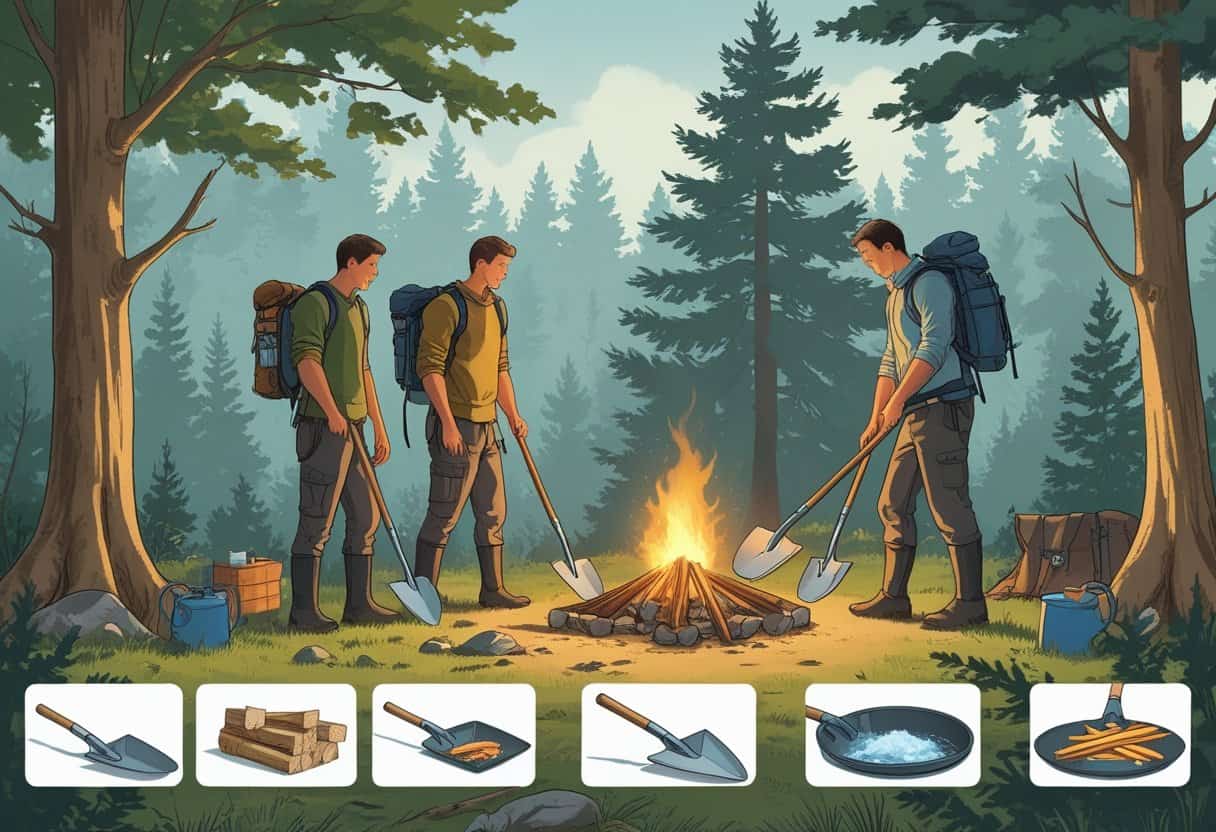
We can rely on a shovel for more than digging soil. It can serve as a tool for safety, shelter, food preparation, and even handling tough weather conditions.
Emergency Self-Defense
A sturdy shovel can act as a last-resort defensive tool if we face danger outdoors. Its solid metal blade and long handle give us reach and leverage, making it more effective than bare hands in an emergency.
We should remember that a shovel is not designed as a weapon, so it is best used only when escape is not possible. In survival scenarios, even compact folding models can provide enough strength to keep threats at a distance.
Some survival shovels are built with reinforced edges or serrated sides. These features make them more versatile for both utility and defense.
Clearing Snow and Ice
Snow and ice can block paths, cover campsites, and make travel unsafe. A shovel allows us to clear walkways, dig out vehicles, and remove buildup around tents or shelters.
Using a flat-edged shovel works best for scraping ice from hard surfaces. For deeper snow, a wide blade helps move more material with less effort.
Keeping the shovel handy in a vehicle during winter travel can prevent us from getting stranded. We should also use proper technique to avoid fatigue.
Short, controlled lifts reduce strain on the back and arms. In freezing conditions, this simple tool can mean the difference between being stuck and staying mobile.
Cooking Tool for Camping
When camping, a shovel can double as a cooking aid. We can use the flat metal surface to move hot coals, adjust firewood, or even serve as a cooking surface if cleaned properly.
Some campers heat the shovel blade in a fire and use it like a griddle for simple foods such as flatbread or bacon. It is important to keep the shovel free of rust and dirt before using it for food.
Multi-use camping shovels often include attachments like saw edges or bottle openers, making them even more useful at mealtime.
Makeshift Shelter Support
In survival situations, a shovel can serve as part of a shelter frame. We can drive the handle into the ground to hold up a tarp or lean it against a tree to create structure.
The flat blade also helps anchor coverings by weighing down edges or pressing soil onto tent stakes. If we lack poles, the shovel can replace them and still provide stability.
This method works well in both forest and open field settings. By combining the shovel with branches, cord, or fabric, we can build a reliable shelter that shields us from wind and rain.
Backyard and Garden Enhancements
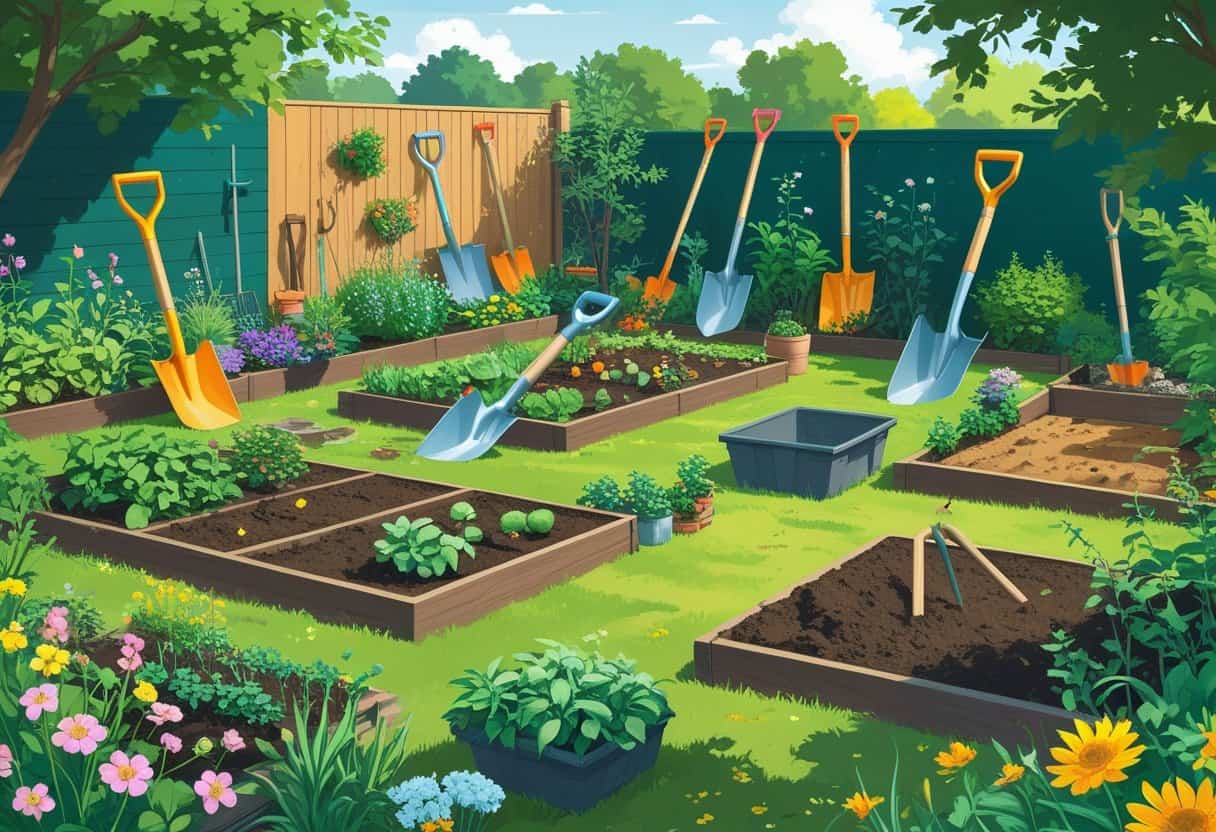
We can get more value from a shovel by using it to shape, organize, and maintain outdoor spaces. Simple adjustments with this tool help us control plant growth, improve movement through the yard, and manage natural waste more efficiently.
Edging Flower Beds
A shovel works well for keeping flower beds neat and defined. By pressing the blade straight down into the soil along the edge, we create a clean line that separates grass from planting areas.
This prevents turf from creeping into beds and makes the garden look more organized. We can also angle the shovel slightly inward to form a shallow trench.
This small barrier helps stop mulch and soil from spilling out. For larger areas, it’s easier to mark the edge with string or a garden hose before cutting.
Unlike plastic or metal edging, this method costs nothing and can be redone each season. The shovel gives us control over curves, corners, and straight lines, making it flexible for both formal and informal garden layouts.
Creating Pathways
Shovels help us build simple and functional garden paths without specialized equipment. We can strip away grass and topsoil to create a flat base for gravel, mulch, or stepping stones.
Keeping the soil level is important so the surface material doesn’t shift or sink. For a more natural look, we can dig shallow outlines and fill them with wood chips or crushed stone.
If we want a sturdier walkway, we can dig deeper, add landscape fabric, and then layer pavers or bricks on top. A shovel also makes it easy to adjust the path width as we go.
This flexibility allows us to create narrow trails for foot traffic or wider paths for wheelbarrows.
Compost Turning Tool
We can use a shovel to manage compost piles more effectively. The wide blade moves large amounts of material at once, which speeds up the mixing process.
Turning compost regularly introduces oxygen, helping organic matter break down faster. A long-handled shovel also keeps us from bending too much, reducing strain while working.
To make the task easier, we can alternate between scooping and lifting to bring the bottom layers to the top. Unlike a pitchfork, which works best for lighter material, a shovel handles dense or wet compost more efficiently.
This makes it a practical choice when we need to move heavier clumps of soil, food scraps, or yard waste within the pile.
Fun and Unusual Activities
We can turn an ordinary shovel into something unexpected by using it for games, sound-making, and creative displays. These activities give us new ways to enjoy a common tool outside of its usual role in the garden or yard.
Shovel Races
Shovel races are a fun outdoor activity where we sit on the shovel head and slide down a grassy hill or snowy slope. The flat metal surface works like a sled, especially in winter when the ground is slick.
To make it safer, we should choose a wide shovel head without sharp edges. Wearing helmets and gloves adds protection.
A sturdy snow shovel often works best because it has a smooth surface and lighter weight. We can organize small races with friends or family by marking a start and finish line.
Keeping the course short and free of obstacles reduces the chance of accidents.
Outdoor Musical Instrument
A metal shovel can double as a percussion instrument. When we strike the shovel head with a stick or mallet, it produces a clear ringing sound.
Different parts of the shovel create different tones, from sharp high notes on the edge to deeper sounds in the center. We can hang the shovel from a tree branch or post so it swings slightly when hit.
This setup improves the sound and makes it easier to play. It also prevents the vibration from being dampened by the ground.
For group activities, several shovels of different sizes can form a simple outdoor sound station. Kids and adults alike can experiment with rhythm, turning garden tools into a playful way to explore music.
Photo Prop for Events
Old shovels make unique props for themed events and casual gatherings. We can paint the shovel head with bright colors, seasonal designs, or even chalkboard paint for writing messages.
This creates a backdrop that adds a rustic or playful touch to photos. At weddings or garden parties, decorated shovels can display signs like “Welcome” or “Love Grows Here.”
For family events, we can use them as fun handheld props in group pictures. Shovels also work well as stands for photo booths.
By sticking the handle firmly into the ground, we create a stable frame to hold signs, flowers, or other decorations that guests can pose with.
Frequently Asked Questions
What innovative ways can a shovel be repurposed for gardening?
We can repurpose shovels as planters, garden signs, or even trellises. For example, an old shovel head can hold a flower pot, or we can paint it and use it as rustic garden art.
Some people also turn them into bird feeders or birdhouse stands.
What are some creative applications of a shovel in landscaping?
Shovels can be arranged into decorative gates, sculptures, or water features. A row of shovel heads can form a rustic fence, while painted shovels add character to garden beds.
We can also build abstract garden art by welding shovel parts together.
How can you modify a shovel for unconventional uses?
We can cut or reshape the metal head to create a smaller tool like a trowel or weeder. Handles can be shortened and reused for tool grips or even ladder rungs.
With welding or basic carpentry, shovels can be adapted into more specialized tools.
